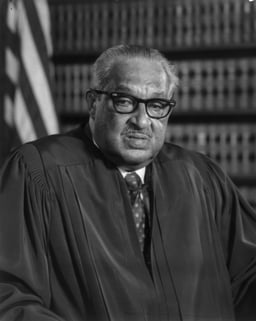Howard University
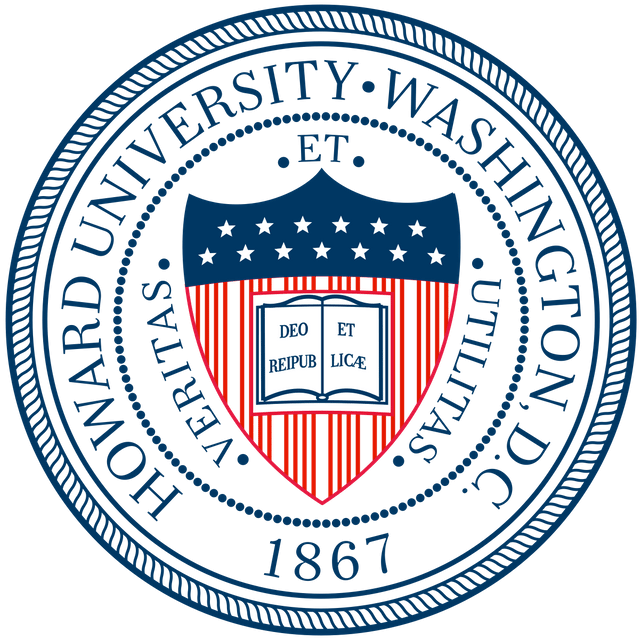
Howard University

Former names | Howard Normal and Theological School for the Education of Teachers and Preachers |
|---|---|
| Motto | Veritas et Utilitas |
Motto in English | "Truth and Service" |
| Type | Private, HBCU |
| Established | March 2, 1867 (1867-03-02) |
Academic affiliations | TMCF NAICU ORAU AASCU CUWMA |
| Endowment | $688.6 million (2018)[1] |
| President | Wayne A.I. Frederick |
| Provost | Anthony Wutoh[2] |
| Students | 10,300[3] |
| Location | Washington, D.C. ,United States 38°55′20″N 77°01′10″W [100] |
| Campus | Urban; 300 acres (1.2 km2) |
| Newspaper | The Hilltop |
| Colors | Blue, White and Red[4] |
| Nickname | Bison and Lady Bison |
Sporting affiliations | NCAA Division I – MEAC |
| Website | home.howard.edu [101] |
 | |
| 1867 | Charles B. Boynton |
| 1867–1869 | Byron Sunderland |
| 1869–1874 | Oliver Otis Howard |
| 1875–1876 | Edward P. Smith |
| 1877–1889 | William W. Patton |
| 1890–1903 | Jeremiah Rankin |
| 1903–1906 | John Gordon |
| 1906–1912 | Wilbur P. Thirkield |
| 1912–1918 | Stephen M. Newman |
| 1918–1926 | J. Stanley Durkee |
| 1926–1960 | Mordecai Wyatt Johnson |
| 1960–1969 | James Nabrit Jr. |
| 1969–1989 | James E. Cheek |
| 1990–1994 | Franklyn Jenifer |
| 1995–2008 | H. Patrick Swygert |
| 2008–2013 | Sidney A. Ribeau |
| 2013–present | Wayne A.I. Frederick |
| University rankings | |
| National | |
| Forbes[46] | 388 |
| Times/WSJ[47] | 117 |
| U.S. News & World Report[48] | 104 |
| Washington Monthly[49] | 102 |
| Global | |
| QS[50] | 581–590 |
| U.S. News & World Report[51] | 692 |
Howard University (Howard or simply HU) is a private, federally chartered historically black university (HBCU) in Washington, D.C. It is categorized by the Carnegie Foundation as a research university with higher research activity and is accredited by the Middle States Commission on Higher Education.
From its outset Howard has been nonsectarian and open to people of all sexes and races. It offers more than 120 areas leading to undergraduate, graduate, and professional degrees.
Howard is classified as a Tier 1 national university. U.S. News & World Report ranked it tied for 104th among national universities, and second among historically black colleges and universities (HBCUs) for 2020.[5] Howard is the only HBCU ranked in the top 40 on the Bloomberg Businessweek business school rankings.[6] The Princeton Review ranked the school of business first in opportunities for minority students and in the top five for most competitive students.[7] The National Law Journal ranked the law school among the top 25 in the nation for placing graduates at the most successful law firms.[8]
Graduates of Howard University include numerous United States diplomats and United States governors, a United States Ambassador to the United Nations, foreign royals, seven foreign heads of state, 11 members of United States Congress, a Supreme Court Justice, directors and executives of Fortune 500 companies, Academy Award and Emmy Award winning actors, Grammy Award winning songwriters and producers, two US Army General’s, a US Air Force General and Vice Chief of Staff of the United States Air Force, and Nobel laureates including Nobel Prize for Literature winner Toni Morrison. Additional alumni include civil rights activists and pioneers in the Civil Rights Movement, a United States Secretay of Health and Human Services, a United States Secretary of Housing and Urban Development, a United States Secretary of Agriculture, 12 Mayors of American cities, and three State Attorney Generals. Howard University has also produced many firsts, including Roger Arliner Young who became the first African-American woman to receive a doctorate in zoology, Benjamin O. Davis Sr. the first African-American US Army General, Thurgood Marshall the first African-American Supreme Court justice, and Edward W. Brooke III who became the first African-American elected to the US Senate among others. Howard University also counts four Rhode Scholars[9][9], 22 Pickering Fellows, 11 Truman Scholars, over 70 Fulbright Scholars, a Schwarzman Scholar, a Goldwater Scholar, and two Pulitzer Prize winners and numerous other Pulitzer Prize nominees among its alumni. To date Howard University has granted over 120,000 degrees[10] and [11] produces the most black doctorate recipients of any university.[12][13]
Former names | Howard Normal and Theological School for the Education of Teachers and Preachers |
|---|---|
| Motto | Veritas et Utilitas |
Motto in English | "Truth and Service" |
| Type | Private, HBCU |
| Established | March 2, 1867 (1867-03-02) |
Academic affiliations | TMCF NAICU ORAU AASCU CUWMA |
| Endowment | $688.6 million (2018)[1] |
| President | Wayne A.I. Frederick |
| Provost | Anthony Wutoh[2] |
| Students | 10,300[3] |
| Location | Washington, D.C. ,United States 38°55′20″N 77°01′10″W [100] |
| Campus | Urban; 300 acres (1.2 km2) |
| Newspaper | The Hilltop |
| Colors | Blue, White and Red[4] |
| Nickname | Bison and Lady Bison |
Sporting affiliations | NCAA Division I – MEAC |
| Website | home.howard.edu [101] |
 | |
| 1867 | Charles B. Boynton |
| 1867–1869 | Byron Sunderland |
| 1869–1874 | Oliver Otis Howard |
| 1875–1876 | Edward P. Smith |
| 1877–1889 | William W. Patton |
| 1890–1903 | Jeremiah Rankin |
| 1903–1906 | John Gordon |
| 1906–1912 | Wilbur P. Thirkield |
| 1912–1918 | Stephen M. Newman |
| 1918–1926 | J. Stanley Durkee |
| 1926–1960 | Mordecai Wyatt Johnson |
| 1960–1969 | James Nabrit Jr. |
| 1969–1989 | James E. Cheek |
| 1990–1994 | Franklyn Jenifer |
| 1995–2008 | H. Patrick Swygert |
| 2008–2013 | Sidney A. Ribeau |
| 2013–present | Wayne A.I. Frederick |
| University rankings | |
| National | |
| Forbes[46] | 388 |
| Times/WSJ[47] | 117 |
| U.S. News & World Report[48] | 104 |
| Washington Monthly[49] | 102 |
| Global | |
| QS[50] | 581–590 |
| U.S. News & World Report[51] | 692 |
History
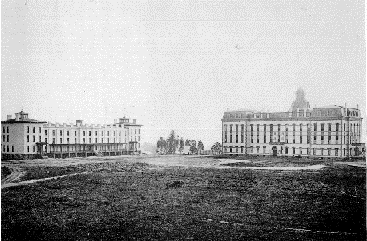
Main Hall (right) and Miner Hall in 1868.

The Lower Quadrangle behind Founders Library; also known as "The Valley."
Shortly after the end of the American Civil War, members of The First Congregational Society of Washington considered establishing a theological seminary for the education of African-American clergymen. Within a few weeks, the project expanded to include a provision for establishing a university. Within two years, the University consisted of the Colleges of Liberal Arts and Medicine. The new institution was named for General Oliver Otis Howard, a Civil War hero, who was both the founder of the University and, at the time, Commissioner of the Freedmen's Bureau. Howard later served as President of the University from 1869 to 1874.[14]
The U.S. Congress chartered Howard on March 2, 1867, and much of its early funding came from endowment, private benefaction, and tuition. (In the 20th and 21st centuries an annual congressional appropriation, administered by the U.S. Department of Education, funds Howard University and Howard University Hospital[15] After five years of being an institution, Howard University became the place of education for over 150,000 freed slaves.[16]
Many improvements were made on campus. Howard Hall was renovated and made a dormitory for women.[17]
From 1926 to 1960, Howard University's first African-American president, Dr. Mordecai Wyatt Johnson, Sr. reigned.[16]
The Great Depression years of the 1930s brought hardship to campus. Despite appeals from Eleanor Roosevelt, Howard saw its budget cut below Hoover administration levels during the Presidency of Franklin D. Roosevelt.[18]
Howard University has played an important role in American history and the Civil Rights Movement on a number of occasions. Alain Locke, Chair of the Department of Philosophy and first African American Rhodes Scholar, authored The New Negro, which helped to usher in the Harlem Renaissance.[19] Ralph Bunche, the first Nobel Peace Prize winner of African descent, served as chair of the Department of Political Science.[20] Beginning in 1942, Howard University students pioneered the "stool-sitting" technique of occupying stools at a local cafeteria which denied service to African Americans blocking other customers waiting for service.[21] This tactic was to play a prominent role in the later Civil Rights Movement. By January 1943, students had begun to organize regular sit-ins and pickets at cigar stores and cafeterias around Washington, D.C. which refused to serve them because of their race. These protests continued until the fall of 1944.[22] Stokely Carmichael, also known as Kwame Toure, a student in the Department of Philosophy and the Howard University School of Divinity, coined the term "Black Power" and worked in Lowndes County, Alabama as a voting rights activist.[23] Historian Rayford Logan served as chair of the Department of History.[24] E. Franklin Frazier served as chair of the Department of Sociology.[25] Sterling Allen Brown served as chair of the Department of English.
The first sitting president to speak at Howard was Calvin Coolidge in 1924. His graduation speech was entitled, "The Progress of a People," and highlighted the accomplishments to date of the blacks in America since the Civil War. His concluding thought was, "We can not go out from this place and occasion without refreshment of faith and renewal of confidence that in every exigency our Negro fellow citizens will render the best and fullest measure of service whereof they are capable."[26]
In 1965, President Lyndon B. Johnson delivered a speech to the graduating class at Howard, where he outlined his plans for civil rights legislation and endorsed aggressive affirmative action to combat the effects of years of segregation of blacks from the nation's economic opportunities.[27] At the time, the voting rights bill was still pending in the House of Representatives.[28]
In 1975 the historic Freedman's Hospital closed after 112 years of use as Howard University College of Medicine's primary teaching hospital. Howard University Hospital opened that same year and continues to be used as Howard University College of Medicine's primary teaching hospital with service to the surrounding community.
Also in 1975, Jeanne Sinkford became the first female dean of any American dental school when she was appointed as the dean of Howard University's school of dentistry.[29]
Recent history
In 1989, Howard gained national attention when students rose up in protest against the appointment of then-Republican National Committee Chairman Lee Atwater as a new member of the university's board of trustees. Student activists disrupted Howard's 122nd anniversary celebrations, and eventually occupied the university's Administration building.[30] Within days, both Atwater and Howard's President, James E. Cheek, resigned.
In April 2007, the head of the faculty senate called for the ouster of Howard University President H. Patrick Swygert, saying the school was in a state of crisis and it was time to end "an intolerable condition of incompetence and dysfunction at the highest level."[31] This came on the heels of several criticisms of Howard University and its management. The following month, Swygert announced he would retire in June 2008.[32] The university announced in May 2008 that Sidney Ribeau of Bowling Green State University would succeed Swygert as president.[33] Ribeau appointed a Presidential Commission on Academic Renewal to conduct a year-long self-evaluation that resulted in reducing or closing 20 out of 171 academic programs.[34] For example, they proposed closing the undergraduate philosophy major and African studies major.[34]
Six years later, in 2013, university insiders again alleged the university was in crisis. In April, the vice chairwoman of the university's board of trustees wrote a letter to her colleagues harshly criticizing the university's president and calling for a vote of no confidence; her letter was subsequently obtained by the media where it drew national headline.[35][36] Two months later, the university's Council of Deans alleged "fiscal mismanagement is doing irreparable harm," blaming the university's senior vice president for administration, chief financial officer and treasurer and asking for his dismissal.[37] In October, the faculty voted no confidence in the university's board of trustees executive committee, two weeks after university president Sidney A. Ribeau announced he would retire at the end of the year.[38] On October 1, the Board of Trustees named Wayne A.I. Frederick Interim President.[39] In July 2014 Howard's Board of Trustees named Frederick as the school's 17th president.[40]
In May 2016, President Barack Obama delivered a commencement address at Howard University encouraging the graduates to become advocates for racial change and to prepare for future challenges.[41]
In 2018, nearly 1,000 students held a sit-in demanding injunction over the administration's use of funding. After the student protest ended, faculty voted "no confidence" in the university president, chief operating officer, provost, and board of trustees.[42]
Campus
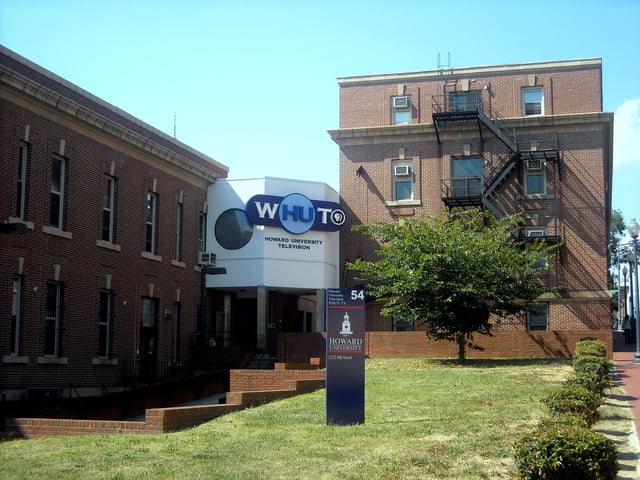
WHUT-TV station in Washington, D.C.
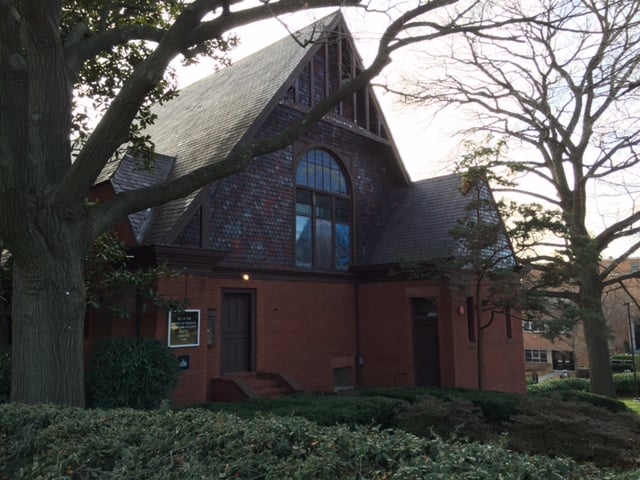
Andrew Rankin Memorial Chapel

WHUR-FM (Howard University Radio)
The 256-acre (1.04 km2; 0.400 sq mi) campus often referred to as "The Mecca" is in northwest Washington.[43] Major improvements, additions, and changes occurred at the school in the aftermath of World War I. New buildings were built under the direction of architect Albert Cassell.[44] Howard's buildings and plant have a value of $567.6 million.[43]
Howard University has several historic landmarks on campus, such as Andrew Rankin Memorial Chapel, Fredrick Douglass Memorial Hall, and the Founders Founders Library.
Howard's Board of Trustees established the Howard University Gallary of Art in 1928. The gallery's permanent collection has grown to over 4,000 works of art and continues to serve as an academic resource for the Howard community.[45]
Howard University has nine residence halls in which students can live: Drew Hall (male freshmen), College Hall North (female freshmen), Tubman Quadrangle (female freshmen), Cook Hall (male undergraduates), Bethune Annex (co-ed, undergraduates), Plaza Towers West (co-ed, for juniors and seniors only), Slowe Hall (co-ed), College Hall South (co-ed), and Plaza Towers East (co-ed, undergraduate honors program students, graduate students).
Howard University Hospital, opened in 1975 on the eastern end of campus, was built on the site of Griffith Stadium, in use from the 1890s to 1965 as home of the first, second and third incarnations of the MLB Senators, as well as the NFL's Washington Redskins, several college football teams (including Georgetown, GWU and Maryland) and part-time home of the Homestead Grays of the Negro National League.
Howard University is home to WHUR-FM 96.3, also known as Howard University Radio. Howard is also home to WHUT-TV, which is a television station on campus next to WHUR-FM.
Organization
The university is led by a Board of Trustees that includes a faculty trustee from the undergraduate colleges, a faculty trustee from the graduate and professional colleges serving 3-year terms, two student trustees, each serving 1-year terms, and three alumni-elected trustees, each serving 3-year terms.[43]
Academics
Schools and colleges
College of Engineering and Architecture
College of Nursing & Allied Health Sciences
College of Pharmacy
Howard University College of Arts and Sciences
Howard University College of Dentistry
Howard University School of Business
Howard University School of Communications
Howard University College of Medicine
Howard University School of Law
Middle School of Mathematics and Science
School of Divinity
School of Education
School of Social Work
Honors programs
Howard offers three highly selective honors programs for its most high-achieving undergraduate students: the College of Arts & Sciences Honors Program, the Executive Leadership Honors Program in the School of Business, and the Annenberg Honors Program in the School of Communications.[52]
Google's Tech Exchange
In 2017, Google Inc. announced it established a pilot residency program named "Howard University West" on its campus in Mountain View, California, to help increase black representation in the tech industry. In 2018, the program expanded from a three-month summer program to a full academic year program and name changed to "Tech Exchange" to be inclusive of other minority serving institutions added to the program.[53] Howard upperclassmen in the program will learn from senior Google engineers, practice the latest coding techniques, and experience tech culture in Mountain View for course credit towards their undergraduate degrees.[54][55]
Research
Interdisciplinary Research Building
Howard's most prominent research building is the Interdisciplinary Research Building (IRB). Opened in 2016, the multi-story, 81,670 square foot, state-of-the-art research facility was completed for $70 million. The IRB was designed to promote more collaborative and innovative research on campus.[56]
Moorland-Spingarn Research Center
"The Moorland-Spingarn Research Center (MSRC) is recognized as one of the world's largest and most comprehensive repositories for the documentation of the history and culture of people of African descent in Africa, the Americas, and other parts of the world. The MSRC collects, preserves, and makes available for research a wide range of resources chronicling black experiences."[57]
NASA University Research Center (BCCSO)
The Beltsville Center for Climate System Observation (BCCSO) is a NASA University Research Center at the Beltsville, Maryland campus of Howard University. BCCSO consists of a multidisciplinary group of Howard faculty in partnership with NASA Goddard Space Flight Center Earth Sciences Division, other academic institutions, and government. This group is led by three Principal Investigators, Everette Joseph, also the director of BCCSO, Demetrius Venable and Belay Demoz. BCCSO trains science and academic leaders to understand atmospheric processes through atmospheric observing systems and analytical methods.[58][59]
Publications
Howard University is home to The Hilltop, the award-winning (Princeton Review) student newspaper. Founded in 1924 by Zora Neale Hurston, The Hilltop enjoys a long legacy at the university, providing students with the ability to learn the newspaper industry.
Howard University is the publisher of The Journal of Negro Education, which began publication in 1932. The Howard University Bison Yearbook is created, edited and published during the school year to provide students a year-in-review. Howard University also publishes the Capstone, the official e-newsletter for the university; and the Howard Magazine, the official magazine for the university, which is published three times a year.
Howard University Libraries

Founders Library is an iconic building on the Howard University campus that has been declared a National Historic Landmark.
Howard University Libraries (HUL) is the library system of Howard University and is composed by eight branches and centers:
The Founders Library, the main library, founded in January 1939.[60][61][62]
The School of Business Library
The School of Divinity Library
The School of Social Work Library
The Moorland-Spingarn Research Center
The Channing Pollock Theatre Collection
The Patent and Trademark Resource Center
The Undergraduate Library (UGL).[63]
Afro-American Studies Center.[64]
Student life
Athletics
Students

The Caribbean Students Association Tree at Howard University.
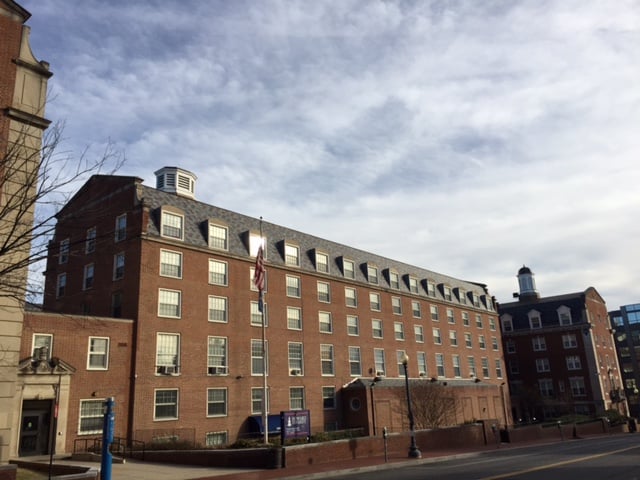
The Harriet Tubman Quadrangle – "The Quad" – consists of five halls housing approximately 640 freshman females only. The resident halls are Wheatley, Baldwin, Frazier, Truth and Crandall Halls.

Howard University Towers East is one of the graduate student dormitories on-campus.
There are over 200 student organizations and special interest groups established on campus.[69]
In 2006, Howard's six-year graduation rate was 68%.[72] In 2009, 1,270 of the 1,476 full-time freshmen enrolled were found to have financial need (86%). Of these, Howard could meet the full financial aid needs of 316 freshmen.[73] Howard's average undergraduate student's indebtedness at graduation is $16,798.[73]
Faculty
Howard faculty include: member of Congress from Maryland Roscoe Bartlett, blood shipment pioneer Charles Drew,[74] Emmy-winning actor Al Freeman Jr.,[75] suffragist Elizabeth Piper Ensley,[76] civil rights lawyer Charles Hamilton Houston, media entrepreneur Cathy Hughes, marine biologist Ernest Everett Just, professor of surgery LaSalle D. Leffall Jr., political consultant Ron Walters, novelist and diplomat E. R. Braithwaite,[77] filmmaker Haile Gerima, and psychiatrist Francis Cress Welsing.
Greek letter organizations

The Zeta Phi Beta Monument in Howard University's lower quadrangle (The Valley).

The Alpha Kappa Alpha Tree on Howard's main yard.
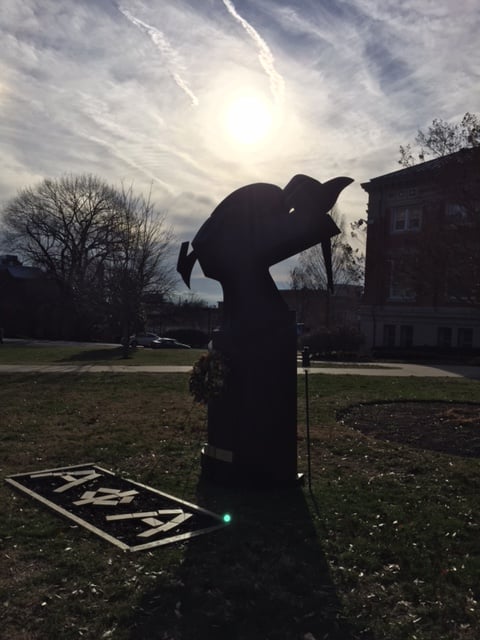
"Symbiosis" by Richard Hunt was a gift to the university by former school trustee Hobart Taylor.[80]
Howard University is the founding site of the National Pan-Hellenic Council (NPHC) and the majority (five of the nine) of the NPHC organizations. The most prestigious chapters (Alpha Chapters) of Alpha Kappa Alpha (1908), Omega Psi Phi (1911), Delta Sigma Theta (1913), Phi Beta Sigma (1914), and Zeta Phi Beta (1920) were established on Howard's campus.[78] However, the Beta Chapter of Alpha Phi Alpha was the first to appear in 1907.[79] Also in 1920, the Xi Chapter of Kappa Alpha Psi appeared on campus, followed by the Alpha Phi Chapter of Sigma Gamma Rho in 1939, and the Alpha Tau Chapter of Iota Phi Theta in 1983.
Other notable Greek letter organizations registered at Howard include Iota Phi Lambda, Phi Beta Kappa, Tau Beta Pi, Delta Sigma Pi, Phi Sigma Pi, Alpha Phi Omega, Alpha Nu Omega, Alpha Kappa Psi, Phi Sigma Rho, Gamma Iota Sigma, Phi Mu Alpha, Sigma Alpha Iota, Gamma Sigma Sigma, Kappa Kappa Psi, Tau Beta Sigma, Chi Eta Phi, and Phi Alpha Delta.
Howard Homecoming
Howard Homecoming week is the most prominent and richest cultural tradition of the institution. Over 100,000 of alumni, students, special guests, and visitors are in attendance to patronize the many events and attractions affiliated with the festive week on and near campus. While the specific calendar of events changes from year to year, many of the traditional homecoming events include the Homecoming Football Game and Tailgate, Pep Rally, Coronation Ball, Greek Step-Show (Howard Greeks only), and Fashion Show. After a two-year hiatus, the Yardfest also returned in 2016 as one of the cherished traditions.[81][82][83]
Springfest
Springfest is an annual tradition that was created by the Undergraduate Student Association (UGSA) to celebrate the arrival of spring. Springfest is similar to Howard's homecoming week in the fall but on a smaller scale and more emphasis on the student body. Springfest events traditionally include the Fashion Show, Greek Step-Show (Howard Greeks only), Vendor Fair, Poetry Showcase, Beauty Conference, Charity Basketball Game, and a major community service event. The schedule of events changes slightly each year.[86][87]
Bison Ball
The Bison Ball and Excellence Awards is an annual black tie gala hosted by the Howard University Student Association (HUSA). A select number of students, faculty, organizations, and administrators from the Howard community are honored for their exceptional accomplishments. This event takes place near the end of every spring semester.[88][89]
Resfest
Resfest week is a Howard tradition that involves freshmen living in residence halls on campus competing in several organized competitions. This event takes place near the end of every spring semester on campus.[90]
Notable alumni
Arts and Media
Hilda Rue Wilkinson Brown, artist and teacher
Debbie Allen, choreographer, actress and singer
Anthony Anderson, Emmy Award-nominated actor and star of the TV show Black-ish
Chadwick Boseman, actor
Ta-Nehisi Coates, writer, MacArthur Fellow
Sean Combs, Grammy Award-winning rapper
Ossie Davis, actor, member of American Theater Hall of Fame
Lance Gross, actor
Taraji P. Henson, Oscar and Emmy-nominated and Golden Globe-winning actress[91]
Shauntay Hinton, beauty pageant winner
Laraaji, new-age musician and performer
Ron "Amen-Ra" Lawrence, Grammy Award-winning producer and writer
Ananda Lewis, television personality
Rita McGhee, Emmy Award-nominated costume designer
Toni Morrison, Nobel Prize and Pulitzer Prize–winning author
Shauneille Perry, stage director and playwright
Phylicia Rashad, actress and singer
Wendy Raquel Robinson, actress
Clarissa Sligh, book artist
Richard Smallwood, award-winning gospel artist
Lori Stokes, television journalist
Maya Stovall, artist[92]
Tracie Thoms, actress and singer
Stan Verrett, anchor on the ESPN and ESPNews networks in the United States
Josephine Turpin Washington, educator and writer
Crystal Waters, recording artist
Susan Kelechi Watson, actress
Marlon Wayans, actor
Nikki Woods, Tom Joyner Morning Show producer
Tanekeya Word, artist
Geri Allen, jazz pianist
Wallace Roney, jazz trumpeter
Benny Golson, jazz saxophonist
Sport
Antoine Bethea, NFL player
Ray Goodlett, soccer player and pastor
Gus Johnson, sports broadcaster
Politics and Public Service
Nnamdi Azikiwe, first president of Nigeria
Ras J. Baraka, mayor of Newark, New Jersey
Vanessa Lowery Brown - Democratic member of the Pennsylvania House of Representatives
Roland Burris, Illinois State Comptroller, Illinois Attorney General, United States Senator,
Stokely Carmichael, an activist and leader in the Civil Rights Movement and Black Power movement
Elijah Cummings, congressman from Maryland
Cheick Modibo Diarra, former Malian prime minister and NASA engineer[93]
David Dinkins, the first African-American mayor of New York City
Rachel Dolezal, activist[94]
Mike Espy, the first African-American U.S. Secretary of Agriculture
Adrian Fenty, former mayor of the District of Columbia
Ronald Sapa Tlau, Rajya Sabha Member of Parliament of India.
Kamala Harris, first African-American, and first Indian-American female Attorney General & US Senator from California
Patricia Roberts Harris, former U.S. Secretary of Housing and Urban Development, and first African-American woman United States Ambassador
Vernon Jordan, attorney, former president of National Urban League
Prince Joel Dawit Makonnen, member of the Ethiopian Imperial Family
Thurgood Marshall, first African-American U.S. Supreme Court Justice
Charlotte E. Ray, first African-American woman lawyer
Kasim Reed, 59th mayor of Atlanta, Georgia
Walter Washington, former mayor of Washington, D.C.
Candice A. Pitts, Councilwoman at the Belize City Council.
Andrew Young, United States Ambassador
Lawrence Douglas Wilder, first African-American since the Reconstruction to serve as a U.S. state and the first elected African-American governor[95]
Business
Ben Ali, co-founder and owner of Ben's Chili Bowl restaurant in Washington, D.C.
Theodora Fonteneau Rutherford, first black CPA in West Virginia
Academia
E. Franklin Frazier, sociologist, namesake of Howard University E. Franklin Frazier Center for Social Work Research
In popular culture
Many episodes of A Different World were inspired by Debbie Allen's experiences as a Howard student. Debbie Allen served as a producer of the show following the first season.[96]
See also
A Bridge Across and Beyond by artist Richard Hunt (a sculpture at the Blackburn Fountain)
List of presidents of Howard University
American Student Dental Association
Russell L. Adams
Howard Theatre

